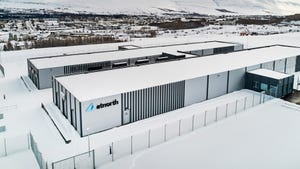NVIDIA Conference: GPU Can Power Big Data Analytics
NVIDIA tackles GPU-powered big data, accelerated virtual desktops, and a visual computing appliance, unrolling multiple announcements at its GPU Tech Conference in San Jose this week.
March 22, 2013

The 2013 GPU Technology Conference is underway in San Jose this week, and NVIDIA shared how it is taking on the top trends in IT with GPU-powered big data analysis, accelerated virtual desktops, and a visual computing appliance. The event conversation can be followed on Twitter hashtag #GTC13.
Keynoting at the beginning of the conference, NVIDIA (NVDA) CEO Jen-Hsun presented about breakthroughs in computer graphics and the NVIDIA GPU roadmap. He shared GPU computing examples and updated participants on remote graphics and product announcements. Jen-Hsun talked about the next two GPUs coming from NVIDIA: the Maxwell - with unified virtual memory for GPU operations to see the CPU memory and vice versa, and the Volta, which is energy efficient and has a new technology called stacked DRAM. Volta will address the problem of access to memory bandwidth. It will have DRAM on same silica sub-strate, and achieve one terabyte per second of bandwidth.
GPU-Powered Big Data Analytics
NVIDIA demonstrated several case studies for how GPUs are being used to tackle big data analytics and advanced search for both consumer and commercial applications. Companies such as Shazam, Salesforce.com and Cortexica use GPUs to process massive data sets and complex algorithms for audio search, big data analytics and image recognition. Top music application Shazam uses GPU accelerators to rapidly search and identify songs from its 27 million track database. Shazam is growing rapidly, with 10 million song searches a day and 2 million new users joining the service every week and its database doubling over the last year.
"GPUs enable us to handle our tremendous processing needs at a substantial cost savings, delivering twice the performance per dollar compared to a CPU-based system," said Jason Titus, chief technology officer of Shazam Entertainment. "We are adding millions of video and foreign language audio tracks to our existing services, and GPU accelerators give us a way to achieve scalable growth."
Visual Computing Appliance
NVIDIA introduced a visual computing appliance, enabling businesses to deliver ultra-fast GPU performance to any Windows, Linux or Mac client on their network. The GRID Visual Computing Appliance (VCA) is a GPU-based system runs complex applications like those from Adobe and Autodesk, sending their graphics over the network to be displayed on a client computer. With the click of an icon a virtual machine, called a workspace, can be created for a dedicated, high-performance GPU-based system. These workspaces can be added, deleted or reallocated as needed.
"NVIDIA GRID VCA is the first product to provide businesses with convenient, on-demand visual computing," said Jen-Hsun Huang, co-founder and chief executive officer, NVIDIA. "Design firms, film studios and other businesses can now give their creative teams access to graphics-intensive applications with un-compromised performance, flexibility and simplicity."
The 4U GRID VCA appliance houses 16 NVIDIA GPUs and GRID VGX software, providing NVDIA Quadro-class graphics performance for up to 16 concurrent users, with low-latency, high-resolution and maximum interactivity. The appliance will be available in the United States in May.
"We've had enormous success using remote GPU acceleration on our content-creation applications," said James Fox, chief executive officer at Dawnrunner, a San Francisco-based film production company. "Thanks to NVIDIA GRID VCA, we don't spend weeks configuring workstations and transcoding files and projects. Instead, we have more time to deliver a higher quality product for our customers. And we can take on new projects with tighter deadlines."
Companies embrace NVIDIA GRID
NVIDIA announced that enterprises can deliver GPU-accelerated virtual desktops and professional graphics applications from the cloud to any device, anytime, anywhere. Dell, HP and IBM are offering NVIDIA GRID-based servers. Citrix, Microsoft and VMware are offering NVIDIA GRID-enabled software. The Dell PowerEdge R720, HP ProLiant WS460c and SL250, and IBM iDataPlex dx350 MR server contain the NVIDIA GRID K1 and K2 boards.
"Enterprises want to take advantage of the growing trends towards globalization and mobility by virtualizing desktops and applications so users can work from anywhere, anytime on any device -- while enabling the company to secure its core IP," said Bob Schultz, group vice president and general manager, Desktops and Apps at Citrix. "By leveraging NVIDIA GRID K1 and K2, combined with Citrix XenDesktop and Citrix XenApp with HDX technology, enterprises can deliver the most graphics-intensive applications to users who require rich, interactive experiences from any device."
NVIDIA GRID enterprise solutions uses NVIDIA GRID VGX software, which unlocks the virtualization and remoting capabilities of NVIDIA GRID GPUs and is licensed by Citrix for use in XenDesktop, XenApp and XenServer; VMware for use in vSphere and Horizon View; and Microsoft for use in RemoteFX. The GRID K1 boards use four Kepler GPUs and 16GB of memory, and K2 boards use two higher-end Kepler GPUs and 8GB of memory.
"Enabling customers to virtualize their multiple workloads is a challenge Dell is committed to, and the NVIDIA GRID technology enables our solutions to be more powerful for design and graphics-intensive applications," said Sally Stevens, vice president of Dell PowerEdge marketing. "Starting with the PowerEdge R720 server this month, and later including Dell Precision workstations and end-to-end Dell Desktop Virtualization Solutions (DVS) Enterprise stacks, Dell will offer a range of robust graphics-virtualized solutions, enabling new customer mobility and data security opportunities that accommodate a wide range of graphics performance requirements."
To keep up with Big Data news, bookmark DCK's Big Data Channel. To stay updated on virtualization, check out our Virtualization Channel.
About the Author
You May Also Like



.jpg?width=300&auto=webp&quality=80&disable=upscale)



